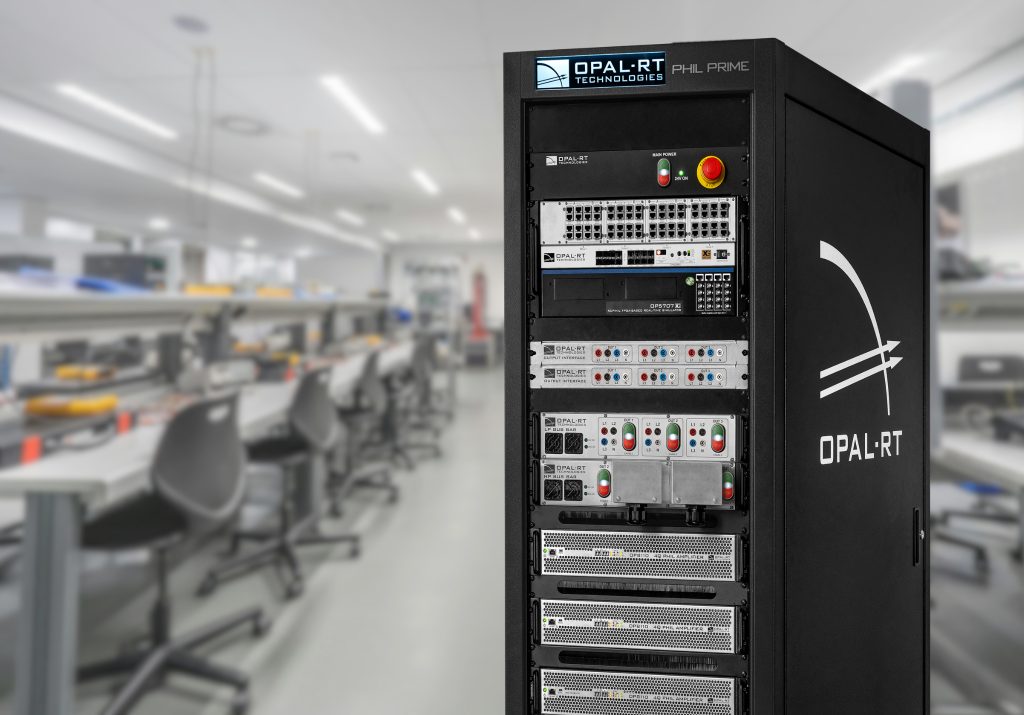OPAL-RT unveils the PHIL Prime test bench: The only fully-integrated test bench on the market

With over 20 years of experience serving the Hardware-in-the-loop (HIL) simulation market, OPAL-RT is proud to announce the release of its PHIL Prime test bench. As close to a hundred PHIL setups have been delivered to utilities and research laboratories worldwide, OPAL-RT continues to demonstrate its commitment to the HIL experience.
The PHIL Prime test bench: An all-in-one solution
The PHIL Prime test bench stands out as the only fully-integrated PHIL test bench on the market. This versatile power testing platform merges the OP1400 and OP1420 test benches into one, offering an improved user experience with easy plug-in & plug-out capabilities. The seamless integration of simulation models with the power amplifier and the ability to easily switch between 120V RMS and 240V RMS emulation with simple wiring adjustments make this test bench particularly user-friendly.
Unique attributes for advanced testing
The PHIL Prime introduces remarkable new features, including the simultaneous integration of multiple devices under test (DUTs) and the parallelization of amplification units within the same test bench. Its improved power output capability now reaches 30 kW. Additionally, extra packages are available, such as the Hybrid AC-DC uGRID and the motor emulator.
Adding power to your simulations
PHIL (Power hardware-in-the-loop) takes HIL testing to the next level by enabling real-time power exchange and precise interaction with electrical transients. A power amplifier, directly controlled by the simulation, interfaces the DUT with the virtual environment. PHIL Prime test benches are engineered for high-fidelity power-level HIL simulations and are accurate across diverse applications.
A versatile platform for numerous applications
The PHIL Prime test bench is suited for a wide range of applications, including:
- Power systems & smart grids: Microgrid and distributed energy resource (DER) testing, renewable energy integration (solar, wind, battery storage), smart inverter testing with distributed energy resource management systems (DERMS).
- Electric drives & transportation: Motor emulation and drives, EV charging station integration to the grid, aircraft and marine power systems, more electrical aircraft systems.
- Academic & research applications: Development of advanced control algorithms, hardware validation of new converter topologies, hybrid virtual and analog laboratory environment testing DERs.
Electric motor emulation for e-mobility
The PHIL Prime Test Bench addresses e-mobility applications with high fidelity motor models for accurate representation of motor dynamics and load behavior. It is equipped with the necessary I/O interfaces to implement application-specific resolvers or encoders. This expands test case coverage while testing traction inverter performance for multiple real-world conditions and allows full power testing without using a real vehicle or real vehicle components.
Versatile connectivity with the smart bus bar
The Smart Bus Bar, available in two variants (LP with 3 x 30 A DUT connections and HP with 2 x 100 A DUT connections), allows extending real-time simulated microgrids into the lab for advanced power emulation. It offers scalability from 5 kW to 30 kW, up to 6 emulated nodes, and real-time control of bus bar contactors from the simulator or a control unit integrated into the HIL environment via digital I/O or Modbus via Ethernet. Real-time voltage & current measurements of all DUTs are available at the simulator for control and manipulation.
The bench also includes a rack-mountable Power Distribution Unit (PDU) for safe connection to the three-phase AC Mains input to the DC power supplies and fast installation. A safety panel with an emergency stop function is also integrated.
Packages for specific solutions
The PHIL Prime offers optional packages such as the Hybrid AC-DC uGRID, realized using either LP or HP Smart Bus Bars and offering local controller options (HIL2GO or OP8666) and a master controller (OP5707 or another simulator). ETS’ Hybrid AC-DC Test Bench, for example, utilizes OPAL-RT’s PHIL test bench for its work on microgrid cybersecurity, grid-tied EVs, V2G, and DER energy management.
OPAL-RT’s PHIL test bench is invaluable to us. It supports our work on microgrid cybersecurity, grid-tied EVs, V2G, and DER energy management. Its remote controllability allows researchers located here and beyond to access it.
Prof. Kamal Al-Haddad
ETS
Advanced validation and testing
Imperial College London uses PHIL to identify on-line admittance in IBR-dominated power systems, while Rensselaer Polytechnic Institute uses a PHIL test bed for grid-connected photovoltaic inverters, demonstrating improved accuracy and reliability compared to purely simulated testing.
The PHIL Prime test bench from OPAL-RT positions itself as an essential tool for researchers, developers, and industry professionals seeking to perform accurate, reliable, and versatile power HIL testing for a wide range of energy and transportation applications.





